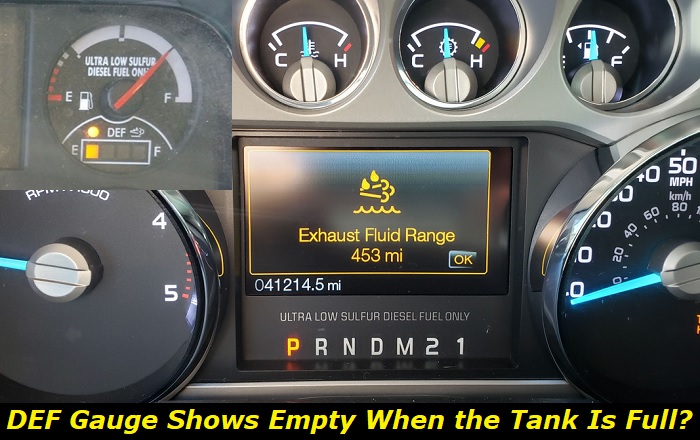DEF, or Diesel Exhaust Fluid, is a fluid that consists of urea and deionized water. Its reservoir is separate from the diesel tank. The fluid is released into the exhaust streams in metered portions to regulate certain emissions.
When this fluid gets into the exhaust pipe, it vaporizes and decomposes to make carbon dioxide and ammonia. These two compounds then react with oxygen and nitrogen oxide inside your vehicle's SCR catalyst to produce three harmless gases: nitrogen, carbon dioxide, and water vapor.

The diesel exhaust fluid uses a gauge that notifies the driver when the fluid is low or empty. The gauge is typically located below or near the fuel gauge. It will notify you when the DEF is at 10% of the full level. After that, the warning may start flashing or going red.
If the DEF drops to zero, your vehicle may automatically come down to 5mph until you refill it.
So, why does your DEF gauge show zero when the tank is full?
Why the DEF Gauge Reads Empty, but the Tank is Full
If you have refilled your DEF reservoir, but the gauge still reads empty, you are not alone, the issue is pretty common.
The first possible remedy is checking if you overfilled or underfilled the tank. Any of these mistakes could cause the DEF gauge to read empty. You should always leave a third of the DEF tank empty.
Read on for some reasons why your DEF gauge reads empty when the tank is full:
1) Overfilling the DEF Tank
The first thing to know about filling the DEF tank is that it shouldn't be filled beyond the top of the tank. Unscrew the cap and look inside: if the fluid is right in the filler neck, this is the problem - the tank was overfilled.
The neck acts as the breathing space for the diesel exhaust fluid. So, you shouldn't fill the fluid beyond it.
Also, the DEF expands by 7% when freezing. If it freezes when overfilled, the tank may just crack. So, it's important to keep it below the maximum allowed level.
You may pump out some fluid using any appropriate tool, but it's not necessary unless you are going to leave the car outside at temperatures below zero. Just keep driving and you should be fine in several weeks when the DEF level goes down and the sensors reset to measure it correctly.
2) Adding DEF into the Wrong Tank
If you have filled your DEF tank, but the gauge still shows empty, you might have poured the fluid into the wrong tank.
Before starting the engine, check to confirm to which tank you dispensed the fluid. If you notice it is in the wrong place, do not panic, and do not power up the engine under any circumstances.
Well, the only tank you could use for this wrongly is the fuel tank. Now, you shouldn't start your car if you suspect that you could've poured DEF into your fuel tank. You will need to call a tow truck and take your vehicle to the shop. If we are talking about a big semi truck, the best solution is to call for road assistance.
3) Faulty DEF Level Sensors
Another reason your DEF gauge is reading empty when the tank is full is due to failed sensors. This happens when the sensors in your DEF tank indicate that you are out of DEF or your vehicle is filled with poor-quality fluid.
Actually, replacing the sensor is not that easy given the DEF pump is hard to reach. In most pickup trucks, you will need to disassemble half of your car to reach the tank and service it. Also, the backorder of parts is another issue. Things are extremely bad with European cars and a little better with American ones.
I don't recommend replacing the DEF sensors on your own - this may take you forever to figure out how you can do this without a good car lift and proper tools.
4) DEF Pump Failure
When the Diesel Exhaust Fluid pump on your vehicle fails, it will no longer be able to inject DEF into the exhaust streams. When this happens, your DEF gauge may be fooled into thinking you are out of fluid.
Several issues could cause the DEF pump to fail:
- If you overfill the fluid DEF tank, it can change the breathing patterns of the tank and the entire system.
- If the fluid is contaminated with rust or dirt.
- The wrong type of fluid was poured into the DEF tank.
- Electric problems, high or low voltage in the system.
- Just an old or low-quality pump that has reached its age or mileage.
Replacing the diesel exhaust fluid pump is not that easy. Again, one of the problems is to reach the pump location. But this depends on the location of the DEF tank.
I strongly recommend calling for professional help if you have problems with the DEF pump. The pump needs to be inspected before you purchase the new one. This is not a cheap part, so replacing it just to check if your inspection is correct is not the best idea you may come up with.
How to Check DEF Level
There is no dipstick or something you can use to check the DEF level. So, you may check it with the help of the gauge on your dash. If the gauge doesn't work, there is only one way you can check the level - actually see the tank and look at the level of the fluid in it.
In some cars, it's close to impossible because the tank is hidden along with the fuel tank. But some vehicles do allow you to see the tank. If it's made of white plastic, you can see the level just by looking at the tank.
If you have no option to check the level, you may pour DEF till it shows up in the filler neck. But then, you will need to pump out some fluid to let the system breeze and prevent it from damage when freezing.
What Happens If My Truck Runs Out Of DEF?
Well, in the majority of vehicles, there is nothing bad in driving without the DEF in the tank. This system affects the exhaust emissions of your car. It doesn't have anything to do with the engine itself, so there is no way the absence of DEF can damage your engine.
But it can obviously affect your emissions, so the majority of vehicles will go to the limp mode when there is no DEF. You will be able to drive at a low speed only till you add some DEF into the tank.
There are obviously no other consequences and no way the engine may be damaged.
Is It Okay to Drive With the DEF Warning Light On?
This highly depends on why the DEF light is on. If the level is low, you can still drive and be OK till the ECU sends the vehicle to the limp mode and you are only able to drive at 5 MPH till the next place where you can buy DEF. This is going to be extremely boring!
But if the DEF warning light is on due to bad quality of DEF or some other fluid in the DEF tank, driving your car may pose some risks to the emission system. If you think it's cheaper to repair than the engine and you can take some risks, you are wrong.
The emission system and the exhaust system in your vehicle are extremely expensive to repair or replace. If there is a risk that the DEF is of low quality or you've poured something else in the DEF tank, just stop your vehicle and call for roadside assistance. Without this, driving your car further may lead to disastrous problems with your vehicle!
Conclusion
It's important to keep the DEF level in your diesel truck or car appropriate for the vehicle to drive safely. While the low level of diesel exhaust fluid will not affect the engine, it may send your vehicle to limp mode and seriously limit its speed and performance. Or it can just shut down the engine and make you walk to the nearest place where you can buy DEF.
If the gauge of the diesel exhaust fluid shows empty but you know that the tank is full, then maybe the sensor in the DEF tank is broken. Or you've poured DEF into another tank. Alternatively, you may have overfilled the tank and now the sensor is freaking out.
I've described all possible solutions for this problem in this article. If you still have any questions, please write them in the comments below!
About the authors
The CarAraC research team is composed of seasoned auto mechanics and automotive industry professionals, including individuals with advanced degrees and certifications in their field. Our team members boast prestigious credentials, reflecting their extensive knowledge and skills. These qualifications include: IMI: Institute of the Motor Industry, ASE-Certified Master Automobile Technicians; Coventry University, Graduate of MA in Automotive Journalism; Politecnico di Torino, Italy, MS Automotive Engineering; Ss. Cyril and Methodius University in Skopje, Mechanical University in Skopje; TOC Automotive College; DHA Suffa University, Department of Mechanical Engineering






Add comment